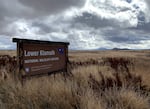
A sign outside Lower Klamath Wildlife Refuge.
Erik Neumann / Jefferson Public Radio
Interested parties attended a congressional hearing on Tuesday aimed at determining how $162 million in government money for Klamath Basin habitat restoration should be spent.
Members of Congress from districts along the Oregon-California border, Tribal members, farming interest groups, and officials with the U.S. Fish and Wildlife Service and Bureau of Reclamation attended the hearing.
The hearing followed the announcement Monday that an initial $15 million will be awarded by the USFWS for projects that “help improve river, riparian, lake and wetland habitats” that support fish, waterfowl and native wildlife.
“This new funding represents a down payment for a brighter future for the Klamath Basin and will go a long way to address a number of the Basin’s highest priority restoration efforts,” said Steve Guertin, deputy director for program management and policy for the U.S. Fish and Wildlife Service.
Funding from the initial grant announcement will be available as soon as the late summer, according to Guertin.
Citing low snowpack and streamflow, on Monday Gov. Kate Brown issued the first drought declaration for 2022 in Oregon for the Klamath Basin. It portends another devastating year for a region still struggling with hundreds of domestic wells that have run dry, an expansive-but-waterless national wildlife refuge system, and farmers and native tribes faced with drought-related threats to their livelihoods.
During the hearing, speakers described the parallel benefits of removing four Klamath River dams, which is slated to begin as soon as next year.
“The complimentary nature of taking out those dams and this ongoing investment in [the Bipartisan Infrastructure Law] will both contribute to restoring the ecological function of the watershed and the healthy ecosystem that all stakeholders need,” Guertin said.
A press release issued Tuesday by the Interior Department describes the broad applications of infrastructure funding: “The Klamath Basin Restoration Program aims to enhance captive-rearing of Endangered Species Act-listed sucker species at the Klamath Falls National Fish Hatchery, address water quality and quantity issues, and support projects that will help improve conditions for waterfowl and salmon and other native species throughout the Basin.”
Rep. Jared Huffman, D-Ca., chair of the House Subcommittee on Water, Oceans and Wildlife, said he hoped to find “durable solutions” with the unprecedented funding in the infrastructure law to benefit communities in the basin.
“It is time to find a path forward that breaks the status quo of litigation, risk and uncertainty over water, that plagues all sides, year after year,” Huffman said.